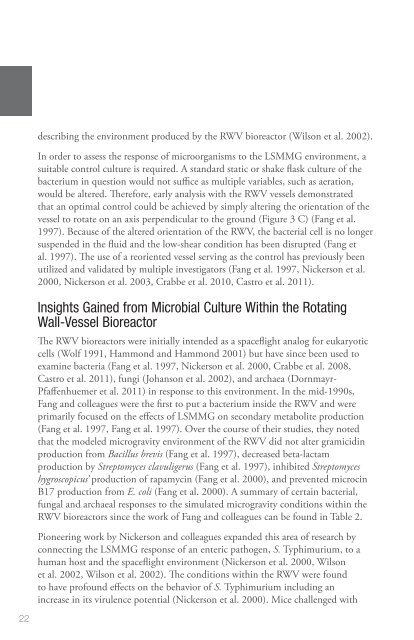Microbial-Observatory-Mini-Book-04-28-14-508
Microbial-Observatory-Mini-Book-04-28-14-508
Microbial-Observatory-Mini-Book-04-28-14-508
You also want an ePaper? Increase the reach of your titles
YUMPU automatically turns print PDFs into web optimized ePapers that Google loves.
describing the environment produced by the RWV bioreactor (Wilson et al. 2002).In order to assess the response of microorganisms to the LSMMG environment, asuitable control culture is required. A standard static or shake flask culture of thebacterium in question would not suffice as multiple variables, such as aeration,would be altered. Therefore, early analysis with the RWV vessels demonstratedthat an optimal control could be achieved by simply altering the orientation of thevessel to rotate on an axis perpendicular to the ground (Figure 3 C) (Fang et al.1997). Because of the altered orientation of the RWV, the bacterial cell is no longersuspended in the fluid and the low-shear condition has been disrupted (Fang etal. 1997). The use of a reoriented vessel serving as the control has previously beenutilized and validated by multiple investigators (Fang et al. 1997, Nickerson et al.2000, Nickerson et al. 2003, Crabbe et al. 2010, Castro et al. 2011).Insights Gained from <strong>Microbial</strong> Culture Within the RotatingWall-Vessel BioreactorThe RWV bioreactors were initially intended as a spaceflight analog for eukaryoticcells (Wolf 1991, Hammond and Hammond 2001) but have since been used toexamine bacteria (Fang et al. 1997, Nickerson et al. 2000, Crabbe et al. 2008,Castro et al. 2011), fungi (Johanson et al. 2002), and archaea (Dornmayr-Pfaffenhuemer et al. 2011) in response to this environment. In the mid-1990s,Fang and colleagues were the first to put a bacterium inside the RWV and wereprimarily focused on the effects of LSMMG on secondary metabolite production(Fang et al. 1997, Fang et al. 1997). Over the course of their studies, they notedthat the modeled microgravity environment of the RWV did not alter gramicidinproduction from Bacillus brevis (Fang et al. 1997), decreased beta-lactamproduction by Streptomyces clavuligerus (Fang et al. 1997), inhibited Streptomyceshygroscopicus’ production of rapamycin (Fang et al. 2000), and prevented microcinB17 production from E. coli (Fang et al. 2000). A summary of certain bacterial,fungal and archaeal responses to the simulated microgravity conditions within theRWV bioreactors since the work of Fang and colleagues can be found in Table 2.Pioneering work by Nickerson and colleagues expanded this area of research byconnecting the LSMMG response of an enteric pathogen, S. Typhimurium, to ahuman host and the spaceflight environment (Nickerson et al. 2000, Wilsonet al. 2002, Wilson et al. 2002). The conditions within the RWV were foundto have profound effects on the behavior of S. Typhimurium including anincrease in its virulence potential (Nickerson et al. 2000). Mice challenged with22


